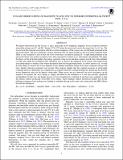VOYAGER OBSERVATIONS OF MAGNETIC WAVES DUE TO NEWBORN INTERSTELLAR PICKUP IONS: 2–6 au
Author(s)
Aggarwal, Poornima; Taylor, David K.; Smith, Charles W.; Joyce, Colin J.; Fisher, Meghan K.; Isenberg, Philip A.; Vasquez, Bernard J.; Schwadron, Nathan A.; Cannon, Bradford E.; Richardson, John D.; ... Show more Show less
DownloadAggarwal-2016-VOYAGER OBSERVATIONS.pdf (1.087Mb)
PUBLISHER_POLICY
Publisher Policy
Article is made available in accordance with the publisher's policy and may be subject to US copyright law. Please refer to the publisher's site for terms of use.
Terms of use
Metadata
Show full item recordAbstract
We report observations by the Voyager 1 and 2 spacecraft of low-frequency magnetic waves excited by newborn interstellar pickup ions H⁺ and He⁺ during 1978–1979 when the spacecraft were in the range from 2 to 6.3 au. The waves have the expected association with the cyclotron frequency of the source ions, are left-hand polarized in the spacecraft frame, and have minimum variance directions that are quasi-parallel to the local mean magnetic field. There is one exception to this in that one wave event that is excited by pickup H+ is right-hand polarized in the spacecraft frame, but similar exceptions have been reported by Cannon et al. and remain unexplained. We apply the theory of Lee & Ip that predicts the energy spectrum of the waves and then compare growth rates with turbulent cascade rates under the assumption that turbulence acts to destroy the enhanced wave activity and transport the associated energy to smaller scales where dissipation heats the background plasma. As with Cannon et al., we find that the ability to observe the waves depends on the ambient turbulence being weak when compared with growth rates, thereby allowing sustained wave growth. This analysis implies that the coupled processes of pitch-angle scattering and wave generation are continuously associated with newly ionized pickup ions, despite the fact that the waves themselves may not be directly observable. When waves are not observed, but wave excitation can be argued to be present, the wave energy is simply absorbed by the turbulence at a rate that prevents significant accumulation. In this way, the kinetic process of wave excitation by scattering of newborn ions continues to heat the plasma without producing observable wave energy. These findings support theoretical models that invoke efficient scattering of new pickup ions, leading to turbulent driving in the outer solar wind and in the IBEX ribbon beyond the heliopause.
Date issued
2016-05Department
MIT Kavli Institute for Astrophysics and Space ResearchJournal
Astrophysical Journal
Publisher
IOP Publishing
Citation
Aggarwal, Poornima, David K. Taylor, Charles W. Smith, Colin J. Joyce, Meghan K. Fisher, Philip A. Isenberg, Bernard J. Vasquez, Nathan A. Schwadron, Bradford E. Cannon, and John D. Richardson. “VOYAGEROBSERVATIONS OF MAGNETIC WAVES DUE TO NEWBORN INTERSTELLAR PICKUP IONS: 2–6 Au.” The Astrophysical Journal vol. 822, no. 2, 94, May 2016, pp. 1-13. © 2016. The American Astronomical Society.
Version: Final published version
ISSN
1538-4357
0004-637X